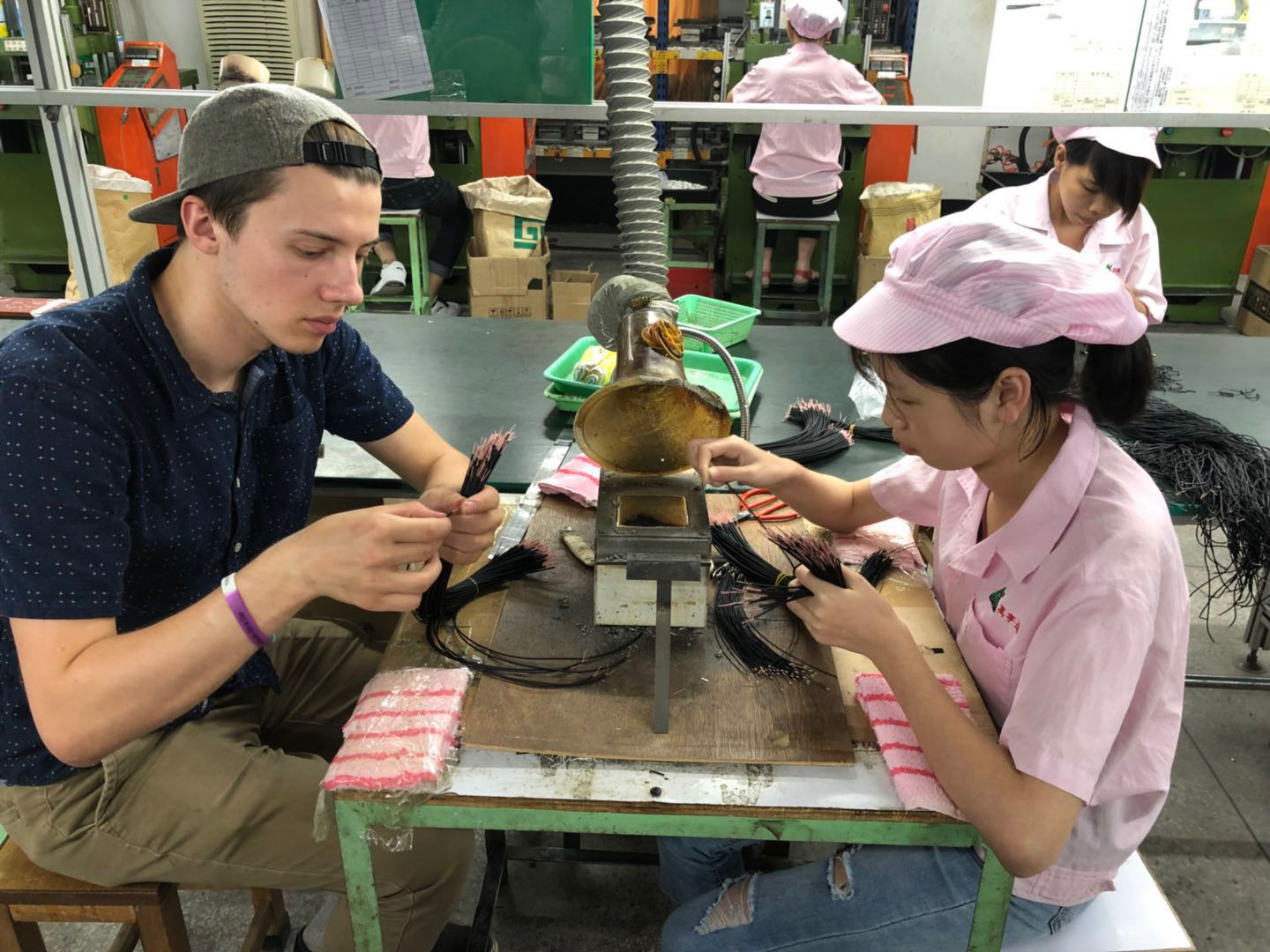- This native Bostonian is a worker on an assembly line in China.
- Mike Gecawicz assembles 3.5 mm headphone cables in Dongguan, a city in Southern China.
- He chose to become a factory worker to gain a better perspective on the products we use everyday.
Mike Gecawicz is a student at the University of Maine, where he studies new media.
He spent his summer break in a headphones factory in Dongguan, China – a city of eight million sometimes called “the factory of the world.”
Gecawicz’s father works in headphones and headsets, and helped connect him with a factory owner in Dongguan. He spent a previous summer in the same factory as a camp counselor for the workers’ kids.
"I'm not entirely sure why they wanted me to come and do this," Gecawicz said in an interview with Business Insider.
"Part of it for me was that most people will go through their entire life and never really know where their product comes from," Gecawicz said. "I wanted to do this as a way to get better exposure to things I don't know so well, and that most people in my position would never get to see."
He's found his summer of dealing with smog, trying solidified blood, and developing headphone models to be "enlightening and rewarding."
"I could recommend it to anybody," said Gecawicz, who is originally from Boston. "It's a great way to get perspective."
Keeping reading for a look into what it was like to work in a Chinese factory.
Gecawicz works at a headphone factory in Dongguan, an industrial city about 55 miles north of Hong Kong.

Source:City Population
Dongguan is in the Pearl River Delta, a highly important trade and economic zone in Southern China. That region alone, with nearly 110 million residents, has a GDP of more than $1.2 trillion.

Source: Forbes
With eight million residents, Dongguan is one of the most important cities in the Pearl River Delta. One in five of the world's smartphones are made there.

Source: The Guardian
Gecawicz said he decided to spend his summer in Dongguan to gain a better perspective of the products he uses every day — and the people who make them.

"You might not care about the iPhone charging cable that you buy for 10 bucks at 7-11, but somebody somewhere put in the effort to make sure that the cable was made right. That was a big factor for me, to gain the appreciation that a lot of people don't have for their products."

Gecawicz's day begins at 9 or 10 a.m., when he leaves his dorm room and walks to the office.

Most factory workers wear uniforms in China. Gecawicz received one, but at six feet tall, he couldn't fit into it. "It was way too small, so they just had me wear whatever," he said.

Gecawicz was on the factory floor earlier this summer, but now he works in the factory's engineering department. He helps develop prototypes for new headphone connectors.

One of the biggest misconceptions Gecawicz said other Americans have about Chinese factories is that they're all sweatshops. They "immediately jump to the conclusion that I'm working with children or in a literal sweatshop."

For instance, the factory workers get hourly breaks, where they use their iPhones or chat with their colleagues. The factory is air-conditioned. "It's a lot like working in an office in the US," Gecawicz said.

Indeed, China is much better off than the average American might believe. "There are still areas where there are villages without running water or power, but that's far less common than a lot of people think it is."

But one belief about China did end up being accurate: the shocking levels of pollution.

The smog in Dongguan obscures the sun. Gecawicz said this makes him tired all the time and that he's developing a vitamin D deficiency, a condition that's common in industrial areas of China due to the prevalent smog.

Source:Nutrients
Around 12:30, Gecawicz has lunch. He usually eats with the members of the sales staff.

The food is made in the factory's kitchen, and it's "phenomenal." Gecawicz highlighted the fried chicken in particular, which he said is better than KFC.

It's customary to take a quick nap after lunch.

Source:CBS News
Then, Gecawicz said, from 1:40 p.m. to 6 p.m., it's back to work.

While Gecawicz worried that his coworkers would dislike him or be unwelcoming, he found that that wasn't the case at all.

"One man I became kinda close with tried to teach me Mandarin. He would point at a box, saying the word for box." The coworker did the same for Gecawicz with numbers, colors, and other objects.

Gecawicz eats dinner at 6 p.m. Dinner food is similar to the lunch cuisine. Most meals consist of rice, cabbage or bok choy, and some sort of meat.

As for the most adventurous foods he's tried, solidified blood, chicken feet, and ox tail all make the list.

After dinner, he goes back to the office so he can use the WiFi there. His dorm's WiFi is not as strong.

Gecawicz, who is one of the few foreigners in his neighborhood, hasn't made a lot of friends in the typical sense, but he's not lonely.

"I've found that even though my Mandarin is very, very slim, I know enough to get around. I've still found that I'm able to make connections with people without speaking. You don't have to be able to share a language to share connections... We aren't all that different."


